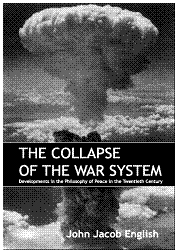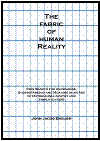|
Choice Publishing Book Store |

|
The Collapse of the War System
Developments in the Philosophy of Peace in the Twentieth Century
John Jacob English
ISBN: 978-1-905451-53-1
Price: € 15.00 |
|
About the Author
John Jacob English PhD is Director of Saor-Ollscoil na hÉireann (The Free University of Ireland) and teaches the Study of Peace course at the college. He is convenor of the Peace Theories Commission of the International Peace Research Association (IPRA). He organises the Visions of Peace Project. This project was established as a result of the Visions of Peace conference 2000 which was organised by Saor-Ollscoil as part of UNESCO’s Decade for the Culture of Peace Programme. The author was awarded the Visionary of Peace Award 2007 by the Education for Peace Foundation (Ireland)
Contact the author at:
To The Reader…
There is one thing stronger than all the armies in the world and that is an idea whose time has come. Victor Hugo
MOVING BEYOND THE PROPAGANDA AND THE ILLUSIONS
Peace should never be seen as some conflict-free utopia. Even the simplest understanding of peace will show that peace is not the absence of conflict but the ability of coping with conflict by peaceful means. Peace will not reduce our security, or our creativity, or our capacity for change. It will actually have the opposite effect. It is violence and the culture of violence that is destroying our security and our capacity for real progressive cultural evolution. The good news is that there is nothing in the nature of Man (Homo Sapiens - the intelligent animal) that enslaves us to violence or aggression. There is nothing in the nature of our social systems that condemns our cultures to perpetual violence. In fact all the information, knowledge and wisdom that is required for us as individuals and for our societies to live in peace are well know and freely available. We should not be waiting for some magical breakthrough in the near future in our understanding of ourselves and our societies that would suddenly create a peaceful world.
It is not necessary for every new generation to try and create or recreate the wheel. The creation of the framework for peace is not now beyond our human imagination or capacity. All the fundamental principles associated with the reduction and elimination of violence and violent aggression in individuals are well known. All the basic information that would prevent group conflicts from degenerating into large-scale violence are also well known. This knowledge has been available for a long time, and it may well be as Mahatma Gandhi said: ‘Puratana and Sanatana –Old and Eternal’. The question we might ask is why there seems to be an almost total failure in the application of the awareness of this knowledge and information, particularly by those people who could make a difference in our world?
It is correct and realistic to recognise that at the beginning of the Twenty First Century there are those cultures that cling to and legitimise the use of violence for a whole range of ideological and pathological reasons. These legitimisations range from the self-interest of the power elites in all areas of human society, in politics through economics to religion. But these legitimisations reflect more about the nature of power than the nature of violence. In any explanation for or against the use of violence the differences between what can be termed: ‘functional violence’ and ‘demented violence’ is of critical importance. The more traditional attempts to try and understand and explain the use of violence are functional in nature - in that the logical explanation for the use of violence seems to be the most realistic. When violence is used without logic or function then it is generally seen as demented violence - however defined. It will be easy enough to point out that: ‘functional violence’ can be or can become: ‘demented violence’ without losing its functionality and vice versa. A particular genocidal policy or procedure may or may not be functional in nature but at the coalface of the implementation its functionality is not the most important consideration.
In any analysis of the role of violence in society it is important to go beyond the more traditional framework of victim and aggressor. The ‘who’ part of the question should never become the central issue. The analysis should never be based on what the X’s did to the Y’s. From a purely analytical point of view it is not important whether the X’s did it the Y’s or the Y’s did it to the X’s; whether as in Jonathan Swift’s: Gulliver’s Travels the Big-Endians did it to the Little-Endians or the Little-Endians did it to the Big-Endians. The vital issue is the development of the awareness that what was done regardless of the victim-aggressor dichotomy was totally unacceptable and criminal in the very worse sense. We must accept that no amount of justification can reduce the responsibility on those who inflict violence either directly or indirectly on others. It cannot be logically argued that the use of aircraft to kill civilians is legitimate in one conflict and criminal in another. The propaganda that supports this type of hypocrisy must have some limits in reality.
The slow dawning of the realisation that we actually have the knowledge that is required to create peace will of course require a paradigm shift in our cultural evolution. But paradigm shifts do happen and the tipping point for the paradigm for peace is much closer than may seem at first glance. Leo Tolstoy predicted that war and violence and the absurdities associated with them would be abolished within one hundred years of the clear statement of the problem. It seems that it will take a little more than the one hundred years. But for very fundamental reasons the ideology of violence will not survive another hundred years. Because if we do not make that paradigm shift into a culture of peace there will be no culture in which a culture of violence will survive even in the short term. This was the central message given by the then Secretary General of the United Nations Boutros Boutros Ghali in his: Agenda for Peace (1992) in the light of his knowledge of just how close on a number of occasions our civilization came to creating nuclear omnicide. Very few species have ever got a second chance at survival and the collapse of the Cold War may have created the possibility of a second chance. The concept of preparing for and waging wars to end wars is just one of the Alice in Wonderland pieces of propaganda that underpins the ideology of violence. If war brought about peace and violence brought about non-violence we would be living in a very peaceful culture. If war and violence solved problems then most of our problems would be solved. The culture of war and violence has to be built on a whole tissues of lies or as Tolstoy calls them a series of: ‘childish absurdities’. But the rejection of these absurdities may be nearer than we think.
There may or may not be a: ‘Turning Point’ when people wake up some morning and say we reject violence in all its forms because we see the damage it has done to our culture, to our creativity, to our vision and to our future possibilities. The process of demystifying violence has been far more gradual. The process has involved de-romanticising, de-rationalising, de-legitimising, and de- culturising the concepts of violence. For much of the twentieth century there had been a naive belief that science, however defined, could rise above the traditional passions of mankind. That science would be the foundation upon which we could build a new enlightenment – a new civilization. But there were always the doubters. Einstein in the: Manifesto to Europeans (1915) asked how could scientists do in the name of the state what once had been done in the name of religion? It may well be that in relation to the actuality of war and violence, reason and science have not and will not contribute to the paradigm shift that is required, but that reason and science have a negative influence on our cultural paradigm.
We might ask how relevant is any peace theory to conflicts that are deeply routed in historical or cultural grievances or to the use of violence that may have its source deep in the reptilian part of the human brain? It is easy to say that peace theories might be fine in the abstract, but in the real world of violent conflict, in the unbelievable cruelty associated with economic and social exploitation, then we might be justified in dismissing theory. Or to say that theories are fine in theory but in the world of real-politic, only force or power matters. To paraphrase the quotation of the Romans: ‘In times of War, the Law is Silenced’, we can now state: ‘In times of Violence, the Theories are Silenced’.
The collapse of the ideology of war will of course not automatically bring about the collapse of the ideology of violence, but it surely follows that a culture of peace cannot be built on a culture of violence. The ideology of war is one of the central foundations of the ideology of violence and just as the horse comes before the cart the collapse of the ideology of war will be a major step in the collapse of the ideology of violence.
27th August 2007 JJE
|

